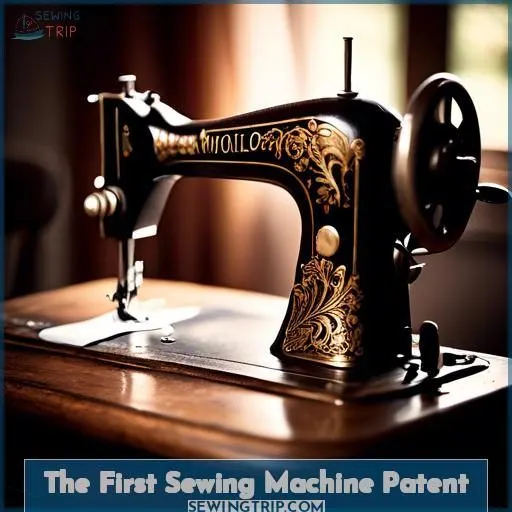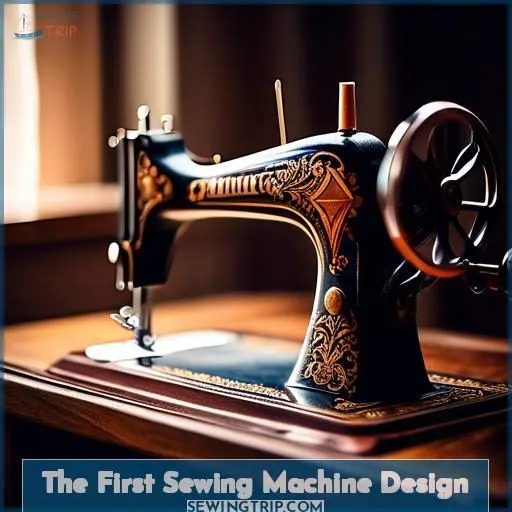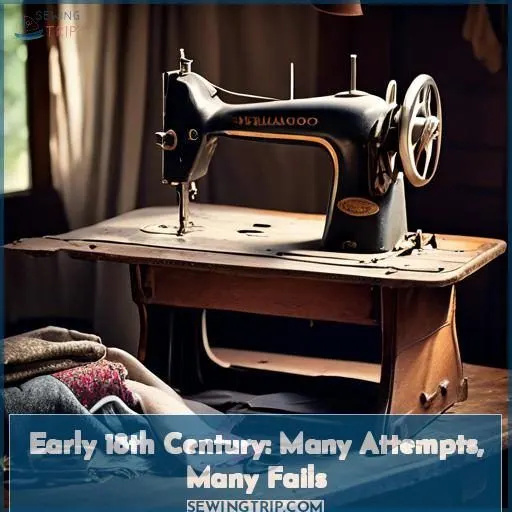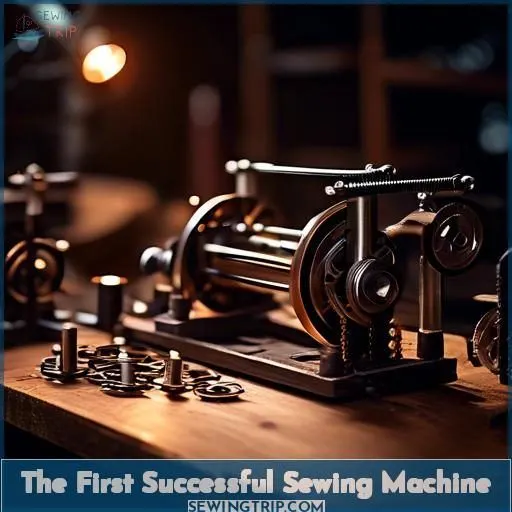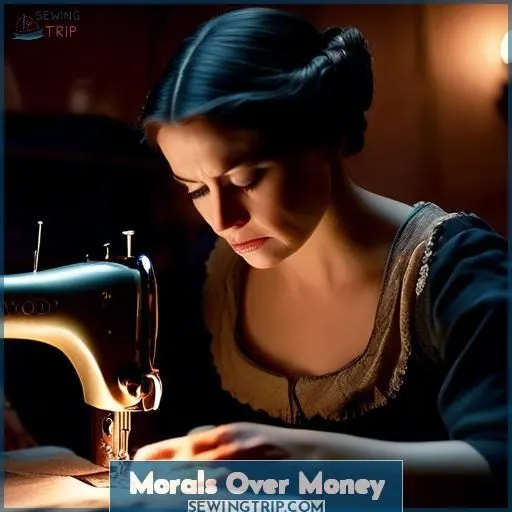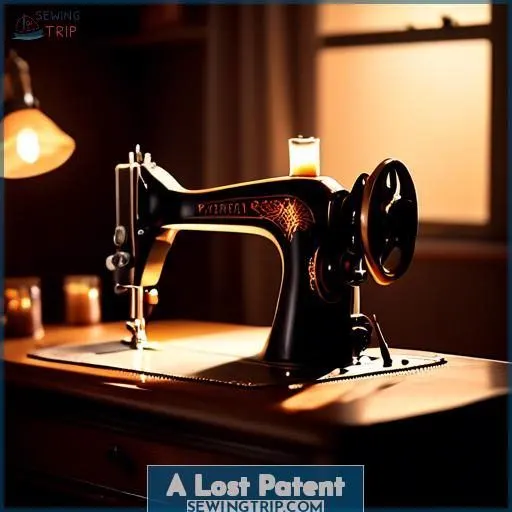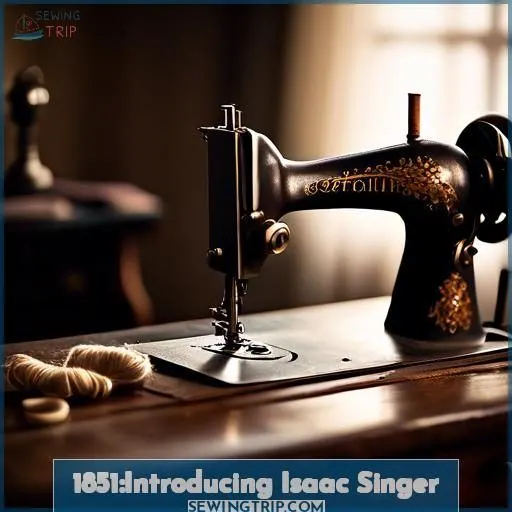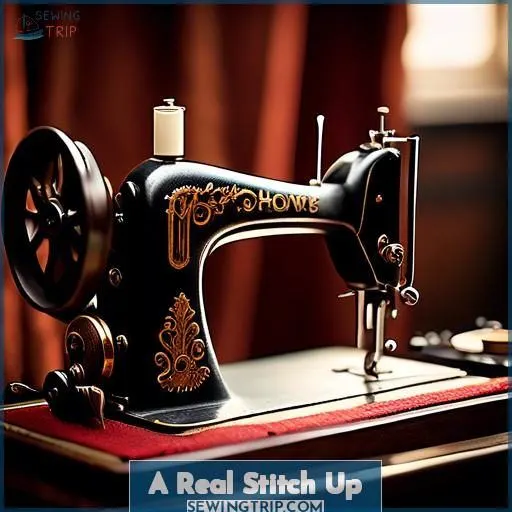This site is supported by our readers. We may earn a commission, at no cost to you, if you purchase through links.
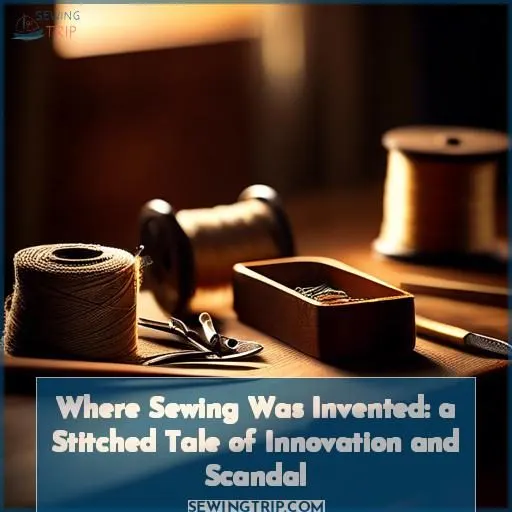
You’ll find that the origins of sewing were centered in Massachusetts, where a young inventor named Elias Howe patented the first practical sewing machine in 1846.
Though initial reception was lackluster, Howe’s revolutionary design, featuring a straight, eye-pointed needle and a reciprocating shuttle, laid the groundwork for the modern sewing machine.
Despite challenges marketing his invention in the United States, Howe sold the British rights for £250, sparking legal battles and patent disputes that would eventually shape the sewing machine industry.
Howe’s design may have started small, but the ripples of his invention are still felt today – and there’s much more to uncover.
Table Of Contents
- Key Takeaways
- Where Sewing Was Invented?
- The First Sewing Machine Patent
- The First Sewing Machine Design
- Early 18th Century: Many Attempts, Many Fails
- The First Successful Sewing Machine
- A Riot & Near Death Experience
- Morals Over Money
- A Lost Patent
- Elias Howe & the Lockstitch
- 1851:Introducing Isaac Singer
- A Real Stitch Up
- Frequently Asked Questions (FAQs)
- Conclusion
Key Takeaways
- Sewing machines were not invented in Massachusetts by Elias Howe in 1846.
- Howe’s design, featuring a straight, eye-pointed needle and a reciprocating shuttle, was one of the first practical sewing machines.
- Despite initial struggles to market his invention in the US, Howe’s patent was instrumental in the development of the sewing machine industry.
- The sewing machine industry was shaped by legal battles and patent disputes, with Howe’s design laying the foundation for modern sewing machines.
Where Sewing Was Invented?
The first sewing machine was invented by Barthélemy Thimonnier in 1830, although it wasn’t the first attempt at creating a sewing machine. Thimonnier was a French inventor who patented his machine and opened a clothing factory that utilized his machines to create army uniforms.
However, his invention wasn’t flawless and faced opposition from tailors who feared it would replace their jobs.
The first practical sewing machine was patented by Elias Howe in 1846, who improved upon Thimonnier’s design and created a machine that used a lockstitch design. Howe’s machine was the first to be truly practical and paved the way for the widespread use of sewing machines in the 19th century.
The First Sewing Machine Patent
Elias Howe, a Massachusetts native, patented the first practical sewing machine in 1846.
Born in Spencer, Howe’s interest in machinery led him to learn the machinist trade and work in a cotton machinery factory in Lowell.
Intrigued by the potential of a sewing machine, he spent five years developing a practical design, eventually obtaining a patent.
However, the initial reception was lackluster, and Howe sold the patent rights in England for £250.
He later moved to England to perfect his machine for sewing leather and similar materials, but his financial condition worsened, and he returned to the US almost penniless.
Despite these challenges, Howe’s patent was instrumental in the development of the sewing machine industry, leading to the widespread use of sewing machines in factories and homes.
The First Sewing Machine Design
In the realm of sewing, embellishing stitches serve as an enchanting means to infuse your creations with personality and allure. These stitches encompass a spectrum, ranging from unadorned zig-zags to elaborate designs mirroring hand embroidery. They can substitute for blanket stitches or satin stitches in machine applique, or enhance quilts with Stitch in the Ditch, adding visual interest and design elements.
To attain proficiency in embellishing stitching, adhere to these guidelines:
- Select your embellishing stitch: Determine if you desire a commonplace embellishing stitch, utilizing a standard needle congruent with your fabric’s composition, or opt for heirloom stitching, employing a wing needle to evoke a nostalgic, heirloom aesthetic.
- Determine the placement of your embellishing stitch: Sketch your project to envision where you wish to incorporate embellishing stitching, such as on collars, hems, or necklines.
- Prepare a remnant of fabric: Exsect a diminutive rectangle from your intended fabric and fortify it with a stabilizer to preclude deformation during sewing.
- Configure your machine for embellishing stitching: Opt for your desired embellishing stitch and ascertain that you have the appropriate presser foot and needle for your machine.
- Practice embellishing stitching on a remnant: Stitch a few inches of the embellishing stitching on your remnant fabric to scrutinize the outcome and implement any requisite adjustments.
Early 18th Century: Many Attempts, Many Fails
In the early 18th century, sewing machines were a topic of great interest and experimentation. Many attempts were made to create a practical sewing machine, but most of them failed. Elias Howe, a skilled machinist, had been working on a sewing machine for years, inspired by his wife’s sewing at home. By 1845, he’d built his first sewing machine and soon constructed an improved model. However, he faced many challenges in marketing his invention in the United States. In 1846, he went to England and sold the British rights for the machine to William Thomas, a large manufacturer of corsets, shoes, and umbrellas.
Upon his return to the U.S., Howe found that some manufacturers, including Isaac Singer, had already begun to make and sell sewing machines similar to his. A five-year legal battle ensued, lasting from 1849 to 1854. Finally, Howe’s patent was declared basic, and he was awarded a royalty on every machine that infringed his patent.
During this time, other inventors were also working on their versions of sewing machines. Some of these designs infringed on Howe’s patent, leading to a series of lawsuits and patent disputes. Despite these challenges, Howe’s invention laid the foundation for the development of practical sewing machines.
As the 19th century progressed, sewing machines became more common, and improvements were made to the design. Isaac Singer, a talented inventor, developed the first practical domestic sewing machine in the 1850s. He formed a partnership with Edward Clark and together they established the Singer Manufacturing Company, which became the largest producer of sewing machines in the world by 1860.
In the following years, Singer secured 12 additional patents for improvements to his machine. He also introduced interchangeable parts, reducing the machines’ size and weight. By 1880, an Edison electric motor was used to drive some Singer sewing machines, and large factories across Europe and the Americas began using them.
The story of sewing machines is a tale of innovation, legal battles, and entrepreneurship. From the early attempts in the 18th century to the successful machines of the 19th and 20th centuries, sewing machines have transformed the way we create and mend textiles.
The First Successful Sewing Machine
The first successful sewing machine was patented by Elias Howe in 1846. This machine used a straight, eye-pointed needle and a reciprocating shuttle to create a lockstitch. Howe’s design was revolutionary, as it allowed for continuous and curved stitching, making it possible to sew on any part of the work. However, despite its innovative features, Howe’s machine didn’t initially gain widespread acceptance. It wasn’t until Isaac Singer improved upon Howe’s design in 1850 that the sewing machine became a commercial success.
Singer’s machine, which he patented in 1851, was the first to employ an overhanging arm that held the needle bar over a horizontal table, making it possible to sew on any part of the work. It also used a foot treadle to power the needle, replacing the cumbersome hand crank. Singer’s machine was the first to be mass-produced with interchangeable parts, which notably reduced production costs. This allowed Singer to sell his machines for a fraction of the price of Howe’s original design, making them affordable for the average American household.
Despite Howe’s patent infringement lawsuit against Singer in 1854, Singer’s machine became the most popular sewing machine on the market. By 1860, Singer’s company had become the largest producer of sewing machines in the world. Singer’s design features have been followed in almost all subsequent sewing machines.
A Riot & Near Death Experience
Elias Howe’s Sewing Machine: A Tale of Invention and Riot
Elias Howe’s journey to invent the sewing machine wasn’t an easy one. His patent for the sewing machine, granted on September 10, 1846, was the first of its kind in the United States. However, his invention sparked a riot among the tailors of his time, who feared that the labor-saving device would make them obsolete.
In the neolithic age, our ancestors used natural fibers and bone needles to sew together animal skins. The first sewing needles were made from bones or animal horns, and the first thread was made from animal sinew. Iron needles were invented in the 14th century, and eyed needles followed in the 15th century.
Fast forward to the 18th century, and many attempts were made to invent a sewing machine. Thomas Saint patented the first practical sewing machine in 1790, but it wasn’t until Elias Howe’s patent that a truly functional sewing machine was developed.
However, Howe’s invention didn’t come without controversy. In 1834, Walter Hunt built America’s first successful sewing machine, but he lost interest in patenting it due to concerns about unemployment. Howe’s machine, which used a lockstitch mechanism, was later adopted by others, leading to a patent battle with Isaac Singer and other inventors.
Despite the challenges, Howe’s sewing machine revolutionized the textile industry. By the 1850s, sewing machines were being used on a large scale, and by the 1890s, the Willimantic Linen Company was a financial success, thanks to the heavy demand for thread for sewing machines.
Today, sewing remains an important tradition with millions of years of history. While most sewing is done by machine, some sewers still perform fine sewing by hand. Sewing machines have automated the sewing process, improving efficiency and accuracy.
Morals Over Money
In the Paleolithic era, our ancestors used bone, antler, and ivory needles for sewing, with animal body parts serving as thread. Sewing was a crucial skill, used for clothing, warmth, and shelter. However, the morality of the sewing industry in those times wasn’t as clear-cut as it’s today. The wealth and ethics of the time weren’t the same as they’re now. The justice system wasn’t as well-defined, and scandals were common.
Fast forward to the medieval era, and sewing became a woman’s occupation, primarily for practical purposes. Clothing was expensive, so women extended the lifespan of items by mending and reusing them. Decorative needlework was highly valued, and sewing tools were included in European brides’ trousseaus.
The Industrial Revolution brought significant changes to the sewing industry. The first sewing machine was patented in 1790 by Thomas Saint, and Isaac Singer developed the first home-use sewing machine in the 1850s. However, this period also saw the emergence of textile sweatshops with underpaid sewing machine operators. Tailors became associated with higher-end clothing.
In the 20th century, sewing machines became more affordable to the working class, and demand for sewing patterns grew. Ebenezer Butterick created paper patterns for home sewers, and women’s magazines carried sewing patterns. Ready-made clothing became more prevalent as women joined the paid workforce, making home sewing primarily a hobby in the Western world.
Today, while sewing is still a tradition with millions of years of history, it’s primarily a hobby in the Western world. Cottage industries exist for custom dressmaking and upholstery, and low-price ready-made clothing reduces demand for home sewing. Sewing remains an art with a rich history and continues to evolve with the times.
A Lost Patent
As we explore further into the chronicles of sewing, it’s essential to grasp the patent squabbles and judicial skirmishes that molded the sector. Elias Howe, the pioneer of the first usable lockstitch sewing machine, encountered considerable hurdles in safeguarding his invention. Although being granted the maiden US patent for a lockstitch sewing machine in 1846, Howe faced numerous obstacles in commercializing his creation.
One of the most notable challenges was the onset of the Sewing Machine Conflict in the 1850s. As more individuals embarked on the production of sewing machines, Howe discovered that his copyrights were being violated. He was compelled to defend his patent privileges in the courts, a procedure that spanned from 1849 to 1854. Howe triumphed in the dispute, but the legal battles were only the opening act.
The subsequent patent thicket was a labyrinthine network of patent infringement claims, with manufacturers like Isaac Singer and others endeavoring to assert their claim to the royalty windfall. This precipitated a flurry of lawsuits and the formation of the inaugural American patent pool in 1856, enabling manufacturers to share the fruits of their creations and avert resorting to the courts. Under this novel arrangement, Howe received $5 royalty for each sewing machine sold in the US, amounting to $2 million.
Despite these trials, Howe’s invention transformed the sewing industry. His sewing machine clinched a gold medal at the 1867 Paris Exhibition and he was posthumously inducted into the National Inventors Hall of Fame. The narrative of Elias Howe and the sewing machine stands as an emblem of the potency of innovation and the legal battles that frequently accompany it.
Elias Howe & the Lockstitch
Elias Howe, the inventor of the lockstitch sewing machine, faced a series of controversies and legal battles that threatened his financial well-being.
- Invention Controversy: Howe’s patent application was rejected due to a prior patent by John Greenough. However, Howe’s design was markedly different, using a locking stitch.
- Patent Infringement: Howe accused various manufacturers of patent infringement, leading to a series of lawsuits.
- Legal Battles: Howe’s legal battles among sewing machine manufacturers led to the Sewing Machine Combination, which consolidated the industry.
- Financial Struggles: Despite these challenges, Howe’s annual income was estimated at $2 million between 1854-1867. He donated his wealth to equip a Union Army regiment and served as a private.
The lockstitch revolutionized sewing machines, contributing to urbanization and industrialization. However, Howe’s financial struggles and legal battles highlight the challenges of patent infringement in the era of sewing machine innovation.
1851:Introducing Isaac Singer
In 1851, Isaac Singer, a multitalented innovator, introduced the first practical home-use sewing machine. Born in Pittstown, New York, in 1811, Singer had already established himself as an inventor by obtaining a patent for a rock-drilling machine in 1839. His journey into sewing machine innovation commenced when he was commissioned to repair a Lerow and Blodgett sewing machine in a Boston machine shop. Within just 11 days, he’d devised and constructed an improved version, which he patented and marketed through I.M. Singer & Company.
Singer’s design was groundbreaking. It was the first sewing machine to facilitate continuous and curved stitching, featuring an overhanging arm that suspended the needle bar over a horizontal table, enabling sewing on any section of the fabric. The movement was transmitted to the needle arm and shuttle via gears. However, Singer’s sewing machine initially failed to gain traction. Priced at over $100, it was prohibitively expensive for the typical American household. Additionally, the garment industry resisted its adoption, with workers enduring long hours for meager wages.
Despite these obstacles, Singer recognized the potential of his creation. He foresaw the transformative impact of the industrial revolution and the significance of interchangeable parts. He invested heavily in equipment engineered to mass-produce sewing machines with interchangeable parts. In late 1857, Singer established the world’s first mass production facility for a product other than firearms in New York. By 1860, I.M. Singer & Company had become the world’s leading producer of sewing machines.
Singer’s sewing machine fundamentally altered the global process of fabric creation and repair, transforming not merely the textile industry but also worldwide commerce. His invention ignited the Sewing Machine War, a legal battle involving numerous inventors and manufacturers. However, Singer’s machine emerged victorious, thanks to the astute business leaders who assumed control of the company, most notably lawyer Edward Clark, who co-founded I.M. Singer & Company.
Isaac Singer’s legacy in the sewing industry is indisputable. His affordable and practical sewing machine ushered the art of sewing into homes and revolutionized the production of clothing. His life story exemplifies the transformative power of innovation and the critical importance of perseverance in the face of adversity.
A Real Stitch Up
After Isaac Singer entered the scene in 1851, the sewing world was never the same. The industrial impact was immediate, sparking patent wars that were as tangled as a spool of sewing thread caught in a gust of wind.
This period of technological advancement wasn’t just about sewing fabric faster; it was a tapestry of social implications, weaving together the threads of fashion evolution. As sewing patterns, needles, and supplies became more accessible, the very fabric of society was stitched anew, transforming how we create and wear clothing.
Frequently Asked Questions (FAQs)
What was the first practical sewing machine patented in the United States?
The first practical sewing machine in the US was patented by Elias Howe in His innovative design transformed textile production and ushered in a new era of industrialization.
Who was the first person to patent a sewing machine in England?
William Thomas, an Englishman, was the first to patent a sewing machine in Just like the threads he sought to stitch, his invention would soon weave itself into the fabric of history.
What was the first successful sewing machine design that used a straight, eye-pointed needle and a reciprocating shuttle?
The first successful sewing machine design that used a straight, eye-pointed needle and a reciprocating shuttle was patented by Elias Howe in This pioneering invention laid the foundation for modern sewing machines.
What was the first sewing machine to employ an overhanging arm holding the needle bar over a horizontal table?
The first sewing machine to feature an overhanging arm design was the 1851 model created by Isaac Merritt Singer. This innovative design allowed for greater flexibility and control when sewing larger garments or fabrics.
Who was the first person to patent a sewing machine in Austria?
The first person to patent a sewing machine in Austria was Josef Madersperger. In 1814, he patented his invention – a machine that used an eye-pointed needle and shuttle mechanism.
Conclusion
Akin to the threads that intertwine to form a tapestry of ingenuity, the story of where sewing was invented weaves an enthralling tale.
From Elias Howe’s revolutionary design to the legal battles that shaped the sewing machine industry, a rich history continues to influence our modern world.
As one steps back and admires the tapestry of innovation, the indelible mark Howe’s invention has left on the very fabric of our lives cannot be overstated.

